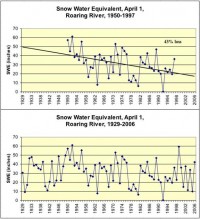By George Taylor, CCM
A few years ago, several papers by scientists at the University of Washington (Mote, 2003; Mote, et al, 2004; Mote, et al, 2005) suggested that snowpack in the Pacific Northwest was declining due to global warming. The Mote papers included the statement: “A study of springtime mountain snowpack in the Pacific Northwest showed widespread declines in snowpack since 1950 at most locations with largest declines at lower elevations indicating temperature effects.” This author responded with an article discussing Northwest snow trends.
Included was the following statement: “Note the starting point for this analysis; the late 1940s-early 1950s were an exceptionally snowy period in Oregon and the Pacific Northwest. The Mote, et al papers used 1950 as a starting point because snowpack measurements were “widespread by the late 1940s” (Mote, et al, 2005) and much less extensive earlier. However, in view of the fact that climate conditions prior to the late 1940s were very different, one might wonder if inclusion of longer period data sets would change the result.” They did. Period-of-record trends were very different for longer data sets than they were for the period beginning in 1950. The conclusions of that analysis: “The use of snowpack trends from 1950 through current suggests a much different (steeper) trend than if period of record measurements are used. Granted, there exist relatively few stations that extend back prior to 1940, but those stations whose records are available make it clear than monotonic decreases in snow pack do not occur through the entire period of record.”

See larger image here.
Nonetheless, the idea that snows were decreasing due to global warming, and would likely keep doing so, became a common and popular one in the Northwest. Seattle’ mayor, Oregon’s Governor, and other public officials rushed to include this “fact” in their policy statements. For example, the Report to the Governor (of Oregon) from the Governor’s Advisory Group on Global Warming (December 2004) stated: “Between 1950 and 2000, the April 1 snowpack declined. In the Cascades, the cumulative downward trend in snow-water equivalent is approximately 50% for the period 1950-1995. Timing of the peak snowpack has moved earlier in the year, increasing March streamflows and reducing June streamflows. Snowpack at low-to-mid elevations is the most sensitive to warming temperatures.?”
However, in 2007 the “snow is going away” idea began to crumble. Washington Associate State Climatologist Mark Albright confirmed that there was no significant long-term trend in snowpack. The winter of 2007-08 was one of the snowiest on record. And last month, the Seattle Times published the following news piece: According to the Times, “Maybe the snow in the Cascade Mountains isn’t in such immediate peril from global warming after all.” “Despite previous studies suggesting a warmer climate is already taking a bite out of Washington’s snowpack, there’s no clear evidence that human-induced climate change has caused a drop in 20th century snow levels, according to a new study by University of Washington scientists.” It is comforting that use of appropriate data records has dispelled some “bad science” conclusions. One hopes that policymakers will recognize this and modify their policies accordingly. Read more here.
Update see this Bruce Hall story ”Telling Tall Tales with Trends” which George’s write-up inspired.




